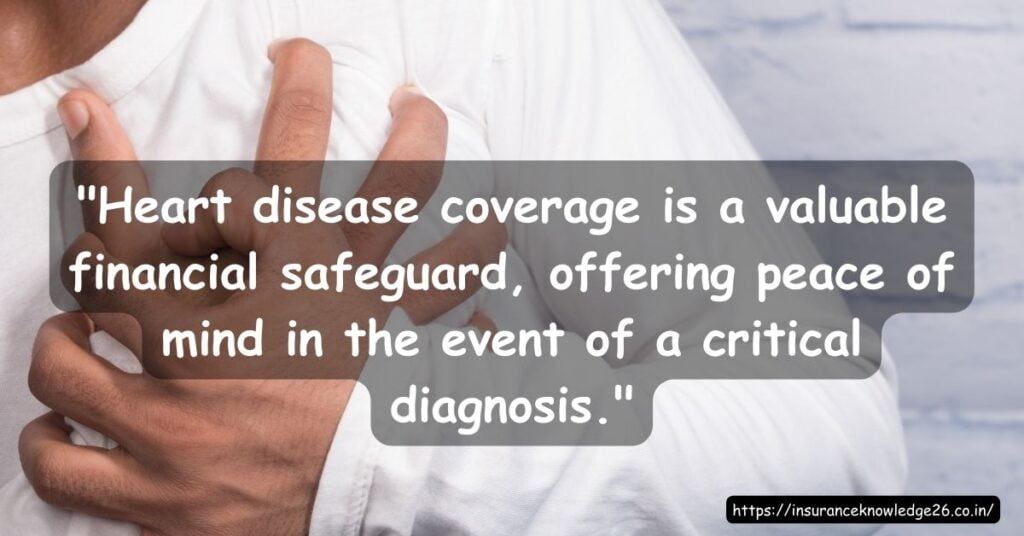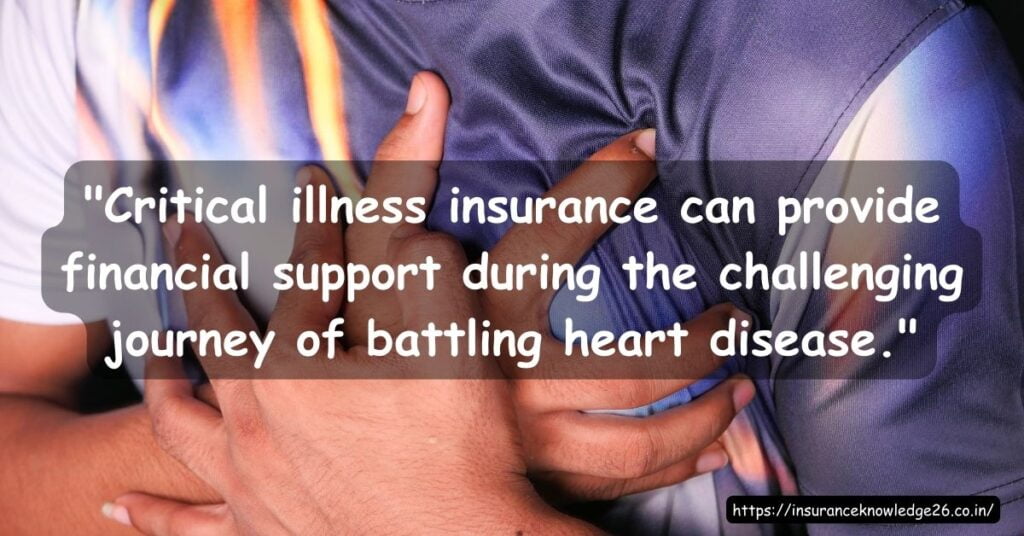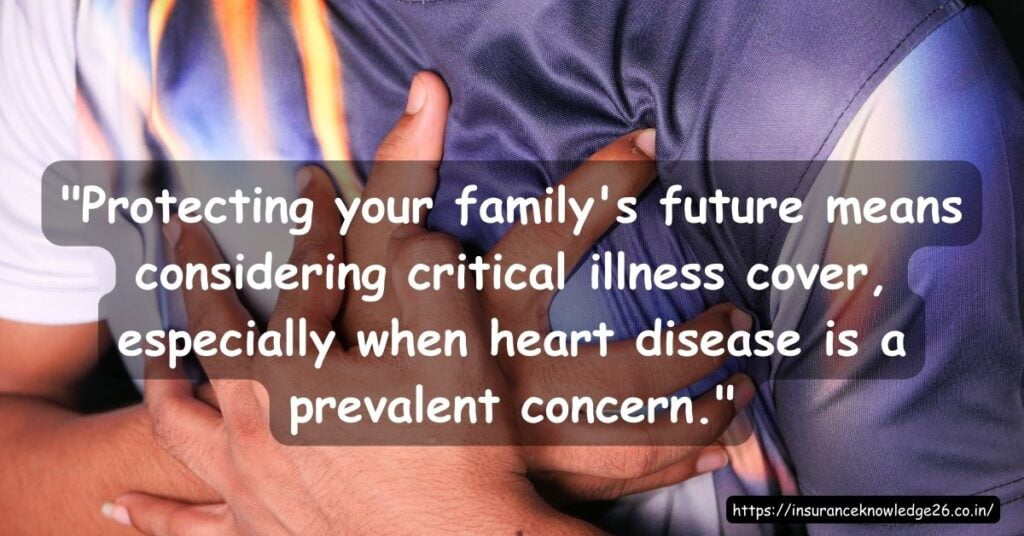In today’s fast-paced world, health uncertainties loom over us more than ever before. Heart disease, a leading cause of death worldwide, remains a significant concern for individuals and families. Amidst the challenges posed by heart-related ailments, the importance of financial security cannot be overstated. This is where Critical Illness Cover steps in, offering a safety net that not only protects against health adversities but also shields one’s financial well-being.

Understanding Critical Illness Cover:
Critical Illness Cover is a type of insurance that provides a lump sum payment in the event of a diagnosed critical illness. It is designed to alleviate the financial burden associated with treating and managing severe health conditions, which can often result in substantial medical expenses and loss of income due to the inability to work. While heart disease is a primary concern, Critical Illness Cover typically covers a range of critical illnesses, including stroke, cancer, organ transplantation, and more, depending on the policy terms.
Heart Disease: An Ongoing Health Challenge:
Heart disease, encompassing various conditions such as coronary artery disease, heart attacks, and heart failure, remains a significant global health challenge. Lifestyle factors, genetic predisposition, and an aging population contribute to its prevalence. With medical advancements, the prognosis for many heart-related conditions has improved, but the cost of treatment can be substantial. From medications to surgeries, the financial strain on individuals and families can be overwhelming, potentially impacting the quality of care and recovery.
The Intersection of Health and Finances:
The connection between health and finances is undeniable. A critical illness not only affects one’s physical well-being but can also lead to a loss of income due to the inability to work during treatment and recovery. Additionally, unforeseen medical expenses can accumulate quickly, including hospitalization, surgeries, medications, rehabilitation, and ongoing medical consultations. This financial stress can exacerbate the emotional and physical toll of dealing with a critical illness.

Benefits of Critical Illness Cover for Heart Disease:
Financial Protection: Critical Illness Cover offers a lump sum payment upon the diagnosis of a covered condition, such as a heart attack or cardiac surgery. This lump sum can be used to cover medical expenses, repay debts, and maintain the standard of living during the recovery period.
Choice and Control: The lump sum payment provides individuals with the flexibility to use the funds as needed. This could include seeking specialized treatments, accessing alternative therapies, or even taking time off work to focus on recovery.
Supporting Loved Ones: Critical illnesses not only affect the individual but also impact the family’s financial stability. The payout from the insurance can alleviate the financial strain on loved ones, allowing them to provide emotional support without worrying about financial matters.
Peace of Mind: Knowing that one is financially prepared to face the challenges of a critical illness can offer peace of mind. This assurance can contribute positively to the mental and emotional well-being of both the individual and their family.
Supplementing Existing Coverage: Critical Illness Cover can complement existing health insurance policies. While health insurance covers medical expenses, Critical Illness Cover provides a lump sum that can cover non-medical costs as well.

Choosing the Right Critical Illness Policy:
Selecting the right Critical Illness Cover requires careful consideration of various factors:
Coverage: Ensure that the policy covers heart-related conditions comprehensively, including heart attacks, cardiac surgeries, and other related illnesses.
Waiting Period: Understand the waiting period before which a claim can be made. Some policies may have a waiting period after the policy purchase.
Exclusions: Familiarize yourself with the policy’s exclusions, which are conditions not covered. Every policy has specific exclusions that need to be understood.
Payout Structure: Some policies offer a tiered payout structure, meaning the sum paid out varies depending on the severity of the illness. Be clear about how the payout is structured.
Premiums: Consider the premium amount and whether it fits your budget. Premiums can vary based on age, health status, coverage amount, and other factors.
Policy Renewal: Check if the policy can be renewed beyond a certain age. Some policies have an age limit for renewals.
Critical Illness Cover for heart disease bridges the gap between health and finances, offering a comprehensive solution to the challenges posed by severe medical conditions. As heart disease continues to impact millions globally, having financial protection in place can provide individuals and families the means to focus on recovery without the added burden of financial worries. It’s crucial to research, compare policies, and choose a plan that aligns with your health needs and financial goals. In an unpredictable world, Critical Illness Cover stands as a valuable safeguard for health and financial security.
FAQs
What is Critical Illness Cover?
Critical Illness Cover is an insurance policy that provides a lump sum payment if you are diagnosed with a covered critical illness, such as heart disease. It aims to alleviate financial burdens associated with medical treatment and loss of income during recovery.
Does Critical Illness Cover specifically include heart disease?
Yes, many Critical Illness Cover policies include heart disease as a covered condition. This can encompass various heart-related conditions like heart attacks, cardiac surgeries, and other heart-related ailments.
How does Critical Illness Cover differ from regular health insurance?
Critical Illness Cover offers a lump sum payout upon diagnosis of a covered condition, whereas health insurance typically covers medical expenses. The lump sum from Critical Illness Cover can be used for various purposes beyond medical bills, such as household expenses and lifestyle adjustments.
Is heart disease the only condition covered under Critical Illness policies?
No, Critical Illness Cover typically includes a range of critical conditions beyond heart disease, such as cancer, stroke, organ transplant, and more. The exact coverage depends on the policy terms.
What factors should I consider when choosing a policy?
It’s important to consider coverage comprehensiveness, waiting periods, exclusions, payout structure, premium affordability, renewal options, and policy terms. Make sure the policy aligns with your specific health needs and financial situation.
Disclaimer
The information provided in this post is based on general knowledge and may not be up-to-date or applicable to specific insurance products or regulations in your jurisdiction. Insurance policies and regulations can vary widely, so it’s essential to research and verify information with local authorities or insurance providers.

